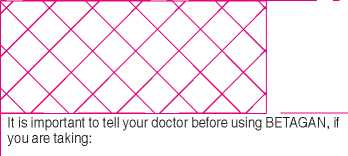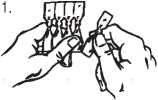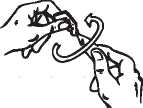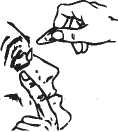Betagan 0.5% W/V Unit Dose Eye Drops Solution
5. How to store BETAGAN
Keep out of the reach and sight of children.
Do not use BETAGAN after the expiry date which is stated on the single-dose container label, the foil covered pouch the container comes in and the carton after “EXP”. The expiry date refers to the last day of that month.
Store the BETAGAN single-dose containers in the pouch to protect them from light. Do not store above 25°C.
Make sure that the single-dose container is intact before use. Each container should only be used once. Do not re-use even if there is solution remaining.
Medicines should not be disposed of via wastewater or household waste. Ask your pharmacist how to dispose of medicines no longer required. These measures will help to protect the environment.

6. Further information What BETAGAN contains
• The active substance is Levobunolol hydrochloride 0.5% w/v
• The other ingredients are poly(vinyl alcohol), sodium chloride, disodium edetate, sodium phosphate dibasic, heptahydrate, potassium phosphate monobasic, sodium hydroxide (to adjust pH) or hydrochloric acid (to adjust pH) and purified water
What BETAGAN looks like and contents of the pack
BETAGAN is a colourless to brown solution in a plastic single-dose (‘Unit Dose’) container.
Each pack contains 30 or 60 of these single-dose containers, arranged in strips of 5, and presented in foil covered pouches. Each container has 0.4 millilitres of eye drops inside.

Read all of this leaflet carefully before you start using this medicine.
• Keep this leaflet. You may need to read it again.
• If you have any further questions, ask your doctor or pharmacist.
• This medicine has been prescribed for you. Do not pass it on to others. It may harm them, even if their symptoms are the same as yours.
• If any of the side effects gets serious, or if you notice any side effects not listed in this leaflet, please tell your doctor or pharmacist.
In this leaflet:
1. What BETAGAN is and what it is used for
2. What you need to know before you use BETAGAN
3. How to use BETAGAN
4. Possible side effects
5. How to store BETAGAN
6. Further information
Not all pack sizes may be marketed.
1. What BETAGAN is and what it is used for
Marketing Authorisation Holder
|
Allergan Limited |
BETAGAN is an eye drop. It is used to treat glaucoma by lowering the pressure that builds up in the eye. | ||
|
Marlow International | |||
|
The Parkway |
Your eyeball contains a watery liquid, which is constantly being drained out of the eye, and new liquid is | ||
|
Marlow |
made to replace this. Glaucoma can occur when the liquid does not drain out quickly enough. This leads to | ||
|
Bucks, SL7 1YL |
raised pressure within the eyeball which can eventually damage your sight. BETAGAN works by reducing | ||
|
United Kingdom |
the production of liquid. This reduces the pressure inside the eye. | ||
|
Tel: 01628 494026 |
BETAGAN belongs to a group of medicines called beta blockers. | ||
|
E-mail: uk_medinfo@allergan.com |
Manufacturer
Allergan Pharmaceuticals Ireland
Castlebar Road
Westport
County Mayo
Ireland
Further information about glaucoma is available from:
International Glaucoma Association (IGA)
Tel: 01233 64 81 70 Fax: 01233 64 81 79 Email: info@iga.org.uk
(The IGA is an organisation which helps glaucoma patients and their relatives, and is not associated with Allergan.)
This leaflet was last revised in May 2014.
To listen to or request a copy of this leaflet in Braille, large print or audio please call, free of charge:
0800 198 5000 (UK only).
Please be ready to give the following information: Levobunolol 0.5% reference number PL 00426/0072.
This is a service provided by the Royal National Institute of Blind People.
2. What you need to know before you use BETAGAN Do not use BETAGAN if
• you are allergic to:
levobunolol
any other ingredients (see section 6 “Further information”)
• you have or have had asthma or other lung diseases (for example severe chronic obstructive pulmonary disease (COPD)) where you have difficulty breathing, wheezing or a chronic cough
• you have or have had heart problems such as slow heart beat, heart failure or heart beat disorders (irregular heart beat).
BETAGAN is not recommended for use in children Take special care with BETAGAN
Talk to your doctor before using BETAGAN if you suffer from, or have in the past suffered from:
• coronary heart disease (symptoms can include chest pain or tightness, breathlessness or choking), heart failure, low blood pressure
• disturbances of heart rate such as slow heart beat
• asthma, breathing problems or chronic obstructive pulmonary disease
• poor blood circulation disease (such as Raynaud’s disease or Raynaud’s syndrome)
• diabetes as levobunolol may mask the signs and symptoms of low blood sugar
• overactivity of the thyroid gland as levobunolol may mask the signs and symptoms of this condition
• any allergies (especially if any of the allergies are severe)
• problems with the surface of your eyes
• eye surgery to lower the pressure in your eye(s)
If you have a history of breathing problems or heart disease your doctor may monitor you more closely as in rare cases death has been reported following taking levobunolol.
If you suffer from allergies, or have a severe allergic reaction be aware that the usual dose of adrenaline may need to be increased.
Tell your doctor before you have an operation that you are using BETAGAN as levobunolol may change effects of some medicines used during anaesthesia.
Other medicines and BETAGAN
Tell your doctor or pharmacist if you are using or have recently used any other medicines.
Tell your doctor before using BETAGAN if you are taking oral beta blockers to lower blood pressure.
BETAGAN is also a beta blocker. Therefore your doctor needs to know whether there is likely to be a risk of having too much beta blocker in your system. The following symptoms could result from such a risk:
• low blood pressure (for example, upon standing)
• slow heart beat
• dizziness/temporary loss of consciousness
• low pressure in the eye ball
Artwork created at 100%
Drop all keylines and notes before printing Part Number: 70032MD079F Drawing Number: 0106901

• medicines to treat high blood pressure (hypertension)
• medicines for heart conditions (for example irregular heartbeat) such as beta blockers, amiodarone or digoxin
• another eyedrop to lower pressure in the eye (glaucoma)
• medicines to dilate your pupil, for example adrenaline
• other beta blockers by mouth or as an eye drop
• medicines to treat diabetes

If the dose of any of your current medicines is changed you should tell your doctor.
Pregnancy and breast-feeding
Tell your doctor before you start using BETAGAN if you are pregnant or breast-feeding, think you may be pregnant or are planning to have a baby.
Like all medicines, BETAGAN can cause side effects, although not everyone gets them. The chance of having a side effect is described by the following categories:
|
Very common |
Occurs in more than 1 out of 10 patients |
|
Common |
Occurs in fewer than 1 out of 10 patients |
|
Uncommon |
Occurs in fewer than 1 out of 100 patients |
|
Rare |
Occurs in fewer than 1 out of 1,000 patients |
|
Very rare |
Occurs in fewer than 1 out of 10,000 patients |
|
Unknown |
The chance of having a side effect is unknown |
You should contact your doctor or go to a hospital immediately if you experience:
• rash, swallowing or breathing difficulties, swelling of your lips, face, throat or tongue (these could be signs of a serious allergic reaction)
• breathing difficulties (including asthma)
• loss of consciousness (or feeling like this)
• unusual or slow heart beat
• low blood pressure
|
The above side effects are serious and in rare cases can be life-threatening. | |||
|
BETAGAN should not be used during pregnancy or breast-feeding unless your doctor, having considered | |||
|
all the risks, still recommends it for you. |
The following side effects may be seen with BETAGAN: | ||
|
Ask your doctor or pharmacist for advice before using any medicine. |
Very common side effects: • eye irritation, eye pain | ||
|
Driving and using machines | |||
|
BETAGAN may cause tiredness, dizziness or blurred/abnormal vision. Do not drive or use machinery until |
Common side effects: | ||
|
these symptoms have cleared. |
• inflammation of the eyelids and outermost layer of the eye |
3. How to use BETAGAN
Always use BETAGAN exactly as your doctor has told you. You should check with your doctor or pharmacist if you are not sure. The usual dose is 1 drop into the affected eye(s), 1 to 2 times a day.
Remove contact lenses prior to application and wait at least 15 minutes after using the eye drops before putting your lenses back in your eyes.
Your doctor will usually check your eye pressure 4 weeks after starting treatment. It may be necessary to use another drug with BETAGAN to control your condition.
Instructions for use
• Wash your hands. Open one of the foil covered pouches containing five single-dose (‘Unit Dose’) containers which are arranged in a strip. Make sure that the single-dose container you intend to use is intact. The solution should be used immediately after opening.
Apply your eye drops in the following way:

2.

3.

4.


1. Tear one single-dose container from the strip.
2. Hold the single-dose container upright (with the top uppermost) and twist off the top.
3. Tilt your head back and look at the ceiling. Gently pull the lower lid down until there is a small pocket. Turn the single-dose container upside down and squeeze it to release a drop into each eye that needs treatment.
4. Whilst keeping the treated eye closed, press your finger against its corner (where the eye meets the nose) and hold for two minutes.
5. Repeat steps 3 and 4 for the other eye, if it also needs treatment.
If a drop misses your eye, try again.
To avoid contamination, do not let the open-end of the single-dose container touch your eye or anything else.
Each container should only be used once, so do not re-use even if there is solution remaining.
Wipe off any excess liquid from your cheek with a clean tissue.
The proper application of your eye drops is very important. If you have any questions ask your doctor or pharmacist.
If you use more BETAGAN than you should
Putting too many drops in your eye(s) is unlikely to lead to unwanted side-effects. If you have placed too many drops in your eye(s), wash your eyes with clean water. Put your next dose in at the usual time.
If, by accident, anyone drinks this medicine, contact your doctor straight away.
If you forget to use BETAGAN
If you forget a dose apply it as soon as you remember, unless it is almost time for your next dose, in which case you should miss out the forgotten dose. Then apply your next dose as usual and continue with your normal routine.
Do not use a double dose to make up for a forgotten dose.
If you stop using BETAGAN
Do not stop using BETAGAN or reduce the amount you are using until your doctor tells you to, since your symptoms may get worse.
BETAGAN should be used as advised by your doctor. If you have any further questions on the use of this product, ask your doctor or pharmacist.
Side effects with unknown frequency:
• eye redness, allergic reaction in the eye, decreased blinking, inflammation of the iris and inner eye or surface of the eye (cornea), blurring of vision, small breaks in the surface of the eye with inflammation, itching of the eye/eyelids, eye and/or eyelid swelling/puffiness, eye discharge or tearing, dry eye, redness and eczema of eyelids
• unusual, irregular, slow or fast heart beat, fainting
• asthma, breathing difficulties, throat irritation, nasal discomfort
• low blood pressure, cold, numbness or discoloration of the hands or feet
• confusion, dizziness, sleepiness, decreased energy, headache, sleeping problems
• depression, nervousness
• swelling of the face, tiredness
• nausea
• skin rashes, hives, flaking and itching, rough patches of skin
Like other medicines applied into the eyes, levobunolol is absorbed into the blood. This may cause similar side effects as seen with beta-blocking agents taken by mouth or injected. Incidence of side effects after topical ophthalmic administration is lower than when medicines are taken by mouth or injected. The side effects listed below include additional reactions seen within the class of beta-blockers when used for treating eye conditions:
• Generalized allergic reactions including swelling beneath the skin that can occur in areas such as the face and limbs, and can obstruct the airway which may cause difficulty swallowing or breathing, severe sudden life-threatening allergic reaction
• Stroke, reduced blood supply to the brain, increases in signs and symptoms of myasthenia gravis (muscle disorder) and unusual sensations like pins and needles.
Low blood glucose levels.
Nightmares and memory loss.
Detachment of the layer below the retina that contains blood vessels following filtration surgery which may cause visual disturbances, corneal erosion (damage to the front layer of the eyeball), dropping of the upper eyelid (making the eye stay half closed), double vision.
• Heart attack, heart failure, chest pain, congestive heart failure (heart disease with shortness of breath and swelling of the feet and legs due to fluid build up), fluid build up in your limbs.
• Cold hands and feet.
• Constriction of the airways in the lungs (predominantly in patients with pre-existing diseases like
asthma), cough...............
• Taste disturbances, indigestions, diarrhoea, dry mouth, abdominal pain, vomiting.
• Hair loss, skin rash with white silvery coloured appearance (psoriasiform rash) or worsening of psoriasis.
• Muscle pain not caused by exercise.
• Sexual dysfunction, decreased libido.
Other side effects reported with eye drops containing phosphates:
In very rare cases, some patients with severe damage to the clear layer at the front of the eye (the cornea) have developed cloudy patches on the cornea due to calcium build-up during treatment.
Reporting of side effects
If you get any side effects, talk to your doctor or pharmacist. This includes any possible side effects not listed in this leaflet. You can also report side effects directly via:
Yellow Card Scheme
Website: www.mhra.gov.uk/yellowcard
By reporting side effects you can help provide more information on the safety of this medicine.